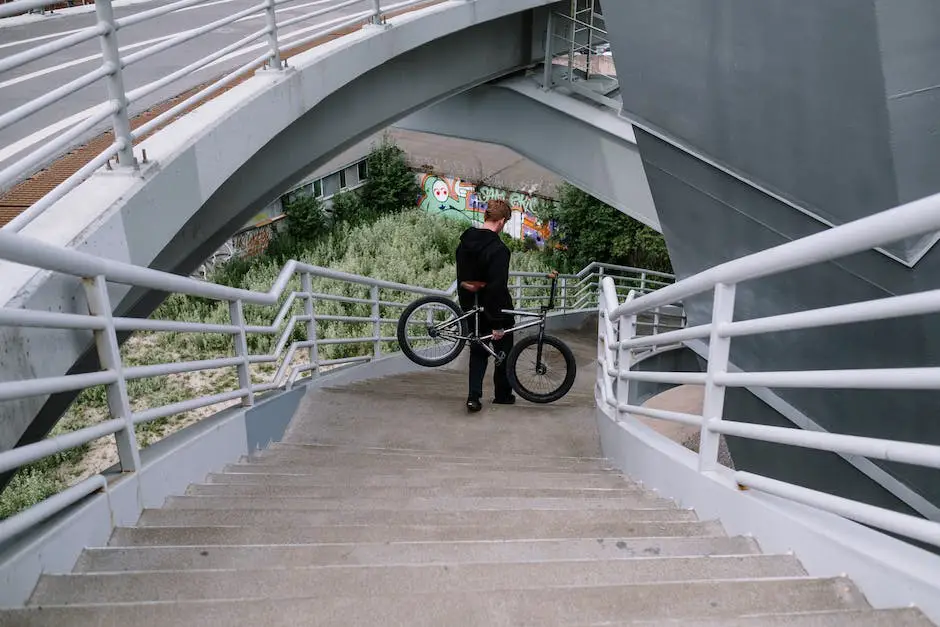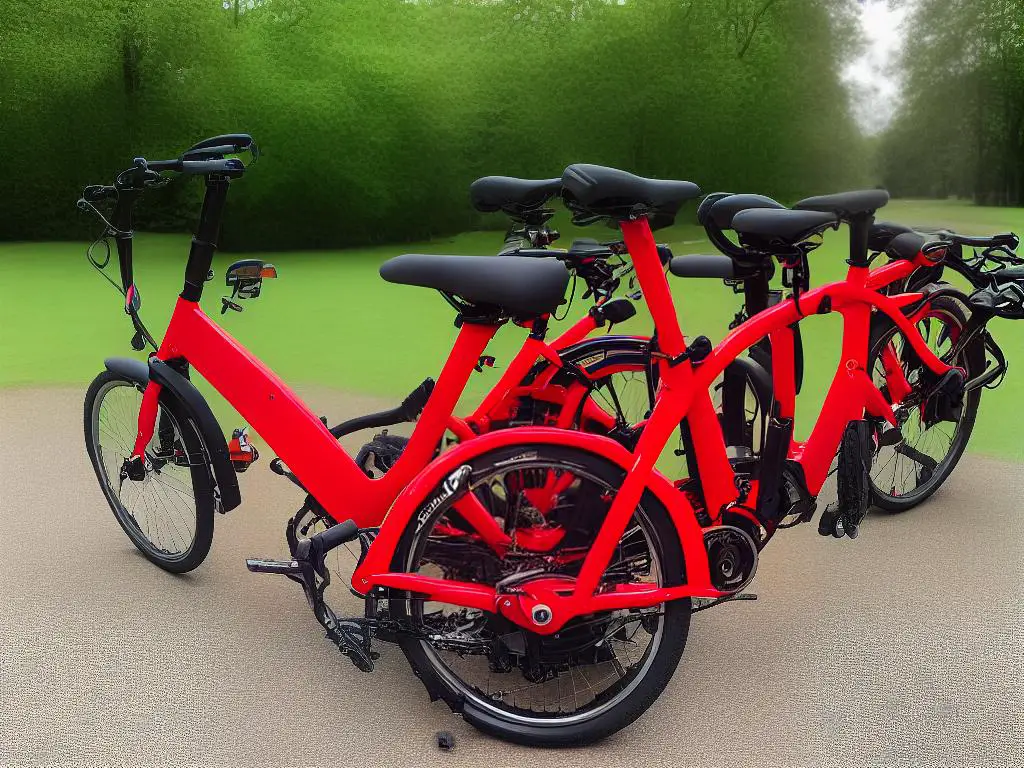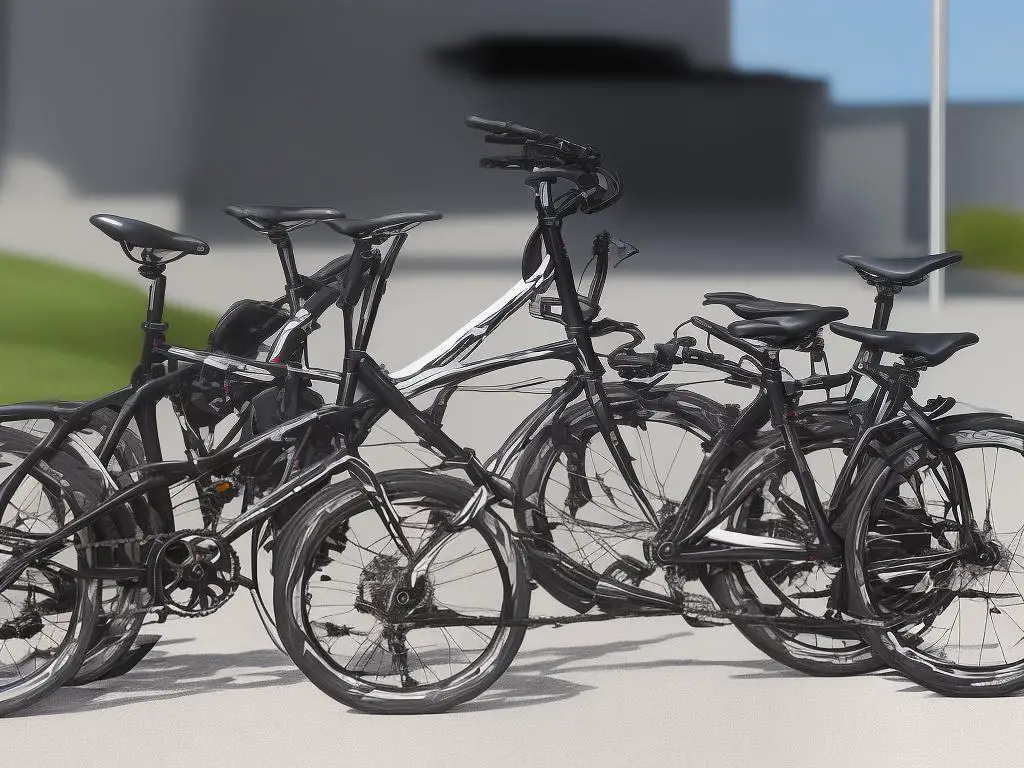Folding Bike vs Regular Bike: Ultimate Comparison
Choosing the right bike can be a daunting task, as there are numerous factors to consider, such as one’s individual preferences, intended use, and available storage space. Folding bikes, which can be compacted for easy transport or storage, have gained popularity in recent years due to their versatility and convenience. On the other hand, regular bikes continue to be a popular choice, offering a wide range of styles and features to suit various purposes. In order to make an informed decision, it’s crucial to examine the key differences between folding bikes and regular bikes in terms of types, portability, performance, cost, maintenance, accessibility, and health benefits.
Types of Folding Bikes
Folding Bikes: The Ultimate Transportation Solution
Folding bikes have become increasingly popular over the years as they provide a compact and convenient form of transportation. One of the main distinctions between folding bikes and regular bikes is the ability to fold and store it in a more compact space. Various types of folding bikes exist, each with its own unique features and folding mechanism. This makes them suitable for different types of commuting and activities while maintaining the functionality and riding experience of a regular bicycle.
Size and Weight
The size and weight of folding bikes vary greatly depending on the type and design of the bike. Some folding bikes are designed with small wheels and a lightweight frame which allows them to be easily folded and carried, making them perfect for commuters that require the bike to fit into tight spaces like a subway car or trunk of a car. Examples of such lightweight folding bikes are the Brompton and Dahon models. Whereas, there are also folding bikes with full-sized wheels, like Montague bikes, which offer a similar riding experience as regular bikes but still have the advantage of being foldable for convenient storage.
Folding Mechanism
Another distinguishing aspect of folding bikes is the folding mechanism used in their design. Some folding bikes utilize a single or double hinge system, where the frame is folded in half or into thirds along these hinges. For instance, bikes such as Tern and Bike Friday use this type of folding system. This design is easy to use, but it may also result in a larger folded size. Alternatively, other folding bikes employ a breakaway system, where the frame can be separated into two or more pieces, such as Ritchey Break-Away models. While this design may not be as fast or convenient as hinge systems, it offers a more compact folded size.
Riding Styles
Folding bikes cater to various types of riding styles, ranging from casual city rides to off-road adventures. For urban commuting, folding bikes with smaller wheels and an upright riding position are ideal, as they offer better maneuverability and adaptability to changing environments. Several folding bike models, such as Brompton and Tern, are designed specifically for urban commuting. On the other hand, folding bikes built for off-road riding and touring often feature larger wheels and more robust frames, like the Montague Paratrooper, which is a full-sized mountain bike that can fold down for easy transport.
Conclusion
In conclusion, folding bikes and regular bikes each cater to different needs and preferences of riders. Folding bikes provide a versatile option for those seeking a compact and portable form of transportation, while regular bikes offer a diverse range of choices tailored to specific riding environments and experiences. Ultimately, the decision between a folding bike and a regular bike depends on the individual’s priorities and intended use.

Types of Regular Bikes
Types of Regular Bikes
Regular bikes come in various types, including mountain, road, city, and e-bikes. Each type of bike has unique features and benefits, which can help riders find the most suitable one for their needs. Comparatively, folding bikes may not have as diverse a range of options but offer the key advantage of portability and adaptability to various environments.
Mountain Bikes
Mountain bikes are designed for off-road cycling and feature wider, knobby tires, suspension systems, and durable frames to withstand impact. These bikes come in different variations, such as hardtail and full suspension, offering better performance on rugged terrain than folding bikes. However, their larger size makes them less portable and may be more challenging to store.
Road Bikes
Road bikes are built for speed and efficiency on paved roads, featuring lightweight frames, narrow tires, drop handlebars, and a more aggressive riding position than folding bikes. Although they excel in high-speed cycling, road bikes may not be as versatile as folding bikes for commuters who need to switch between different modes of transportation due to their size.
City Bikes
City bikes are a versatile option that combines the best features of road and mountain bikes, making them suitable for urban riders who do not require the portability of a folding bike. These bikes are designed for comfort and practicality, boasting wider tires, a more upright riding position, and often featuring additional accessories such as fenders and racks for carrying cargo.
Electric Bikes
Electric bikes (e-bikes) have a battery-powered electric motor that provides pedal assistance, making cycling more accessible for people of varying fitness levels. E-bikes can be bulkier, heavier, and more expensive than regular and folding bikes, but they have the advantage of making hill climbing or long-distance cycling easier.
Choosing the Right Bike
When choosing a bike, it’s essential to consider factors such as riding terrain, frequency of use, storage limitations, and personal preferences. Every type of regular bike provides specific benefits in terms of performance, stability, and comfort, but they often lack the portability and convenience that folding bikes offer.

Portability and Storage
Folding Bikes vs. Regular Bikes
With regard to portability and ease of transportation, folding bikes have a clear advantage over regular bikes. These bikes are specifically designed to be compact and lightweight, making them much easier to carry and transport. Most folding bikes can be collapsed in a matter of seconds, enabling users to effortlessly bring them onto buses, trains, or the subway system. This is especially valuable for multi-modal commuters who rely on a combination of cycling and public transit to get around.
In contrast, regular bikes may not be permitted on some public transportation systems or might require special permits, racks, or designated spaces, making them less suitable for such purposes.
Storage Space Requirements
Storage space requirements also vary between folding and regular bikes. A folding bike can easily be stored in tight spaces such as a small apartment, office, or even the trunk of a car. Some folding bikes are designed to stand upright when folded, which means they take up even less floor space. Regular bikes, on the other hand, typically require a larger storage area, such as a designated bike room, garage, or outdoor bike rack.
This can be problematic for city-dwellers or apartment residents who may have limited space to store a bicycle.
Compatibility with Public Transit Systems
In terms of compatibility with public transit systems, folding bikes generally have the upper hand. Many transit systems allow folding bikes on board, even during peak hours, as they don’t take up much space and can be stored easily in designated areas. Some cities even explicitly welcome folding bikes on their transit systems, recognizing the benefits they offer to riders who need a flexible transportation solution.
Regular bikes, in comparison, may face limitations on when and where they can be carried onto transit vehicles, making it less convenient for multi-modal commuters.
Security Benefits
Aside from storage and transportation benefits, folding bikes offer a level of security not always found with regular bikes. By nature of their design, folding bikes can be taken inside with the user, rather than being left locked up outside, where they may be more susceptible to theft or vandalism. Moreover, folding bikes are less conspicuous when stored indoors, which can add an additional layer of theft prevention.
Of course, this doesn’t mean that regular bikes can’t be stored securely, but it may be more difficult or require additional measures and investments in security tools.
Potential Drawbacks
One potential drawback of folding bikes, especially when considering their portability and storage advantages, is their typically smaller wheel size and more compact frame. This design aspect is essential for their folding capabilities; however, it can result in a less comfortable ride for some users, particularly over longer distances or rough terrain.
On the other hand, regular bikes may offer a smoother and more comfortable riding experience due to their larger wheels and sturdier frames. Still, they come with the trade-off of decreased portability and increased storage requirements, which might not be ideal for those looking for easy transportation and storage solutions.

Performance Evaluation
Performance Comparison between Folding Bikes and Regular Bikes
For folding bikes and regular bikes, speed is an important factor in evaluating performance. One might assume that regular bikes are faster due to their larger wheels and more stable frames. Nonetheless, user testimonials and expert reviews have shown that folding bikes can be just as fast as their non-folding counterparts. Some folding bikes are specifically designed for high performance, utilizing lightweight materials and advanced gear systems, enabling them to reach impressive speeds. However, the speed of any bike ultimately depends on the rider’s skill and fitness level.
Another crucial performance aspect is comfort. Many folding bike enthusiasts have reported comfortable rides with their bikes despite the smaller wheel size, attributing this to well-designed frames and adjustable components such as handlebars and saddles. Meanwhile, regular bikes typically offer a wider range of sizes and configurations, making it easier for riders to find a perfect fit. Furthermore, some riders appreciate the suspension systems found on regular bikes, which provide a smoother ride on rough terrain. Before purchasing a bike, it is essential to try it out and ensure it provides a comfortable fit and ride.
Both folding bikes and regular bikes differ in stability as well. The compact design of folding bikes may seem less stable compared to regular bikes, especially for those new to folding bikes. However, riders who are experienced with folding bikes often find that the smaller wheels offer greater maneuverability, making these bikes suitable for urban environments or crowded spaces. Furthermore, folding bike manufacturers have made significant advancements in recent years to improve the stability offered by their products. In general, a bike’s stability is influenced by factors such as the rider’s skill level, terrain, and personal preferences.
Durability is another essential performance indicator for both folding and regular bikes, impacting longevity and reliability. Generally, both folding and regular bikes can be highly durable when well-maintained and well-constructed. However, folding bikes may require more frequent maintenance due to their complex folding mechanisms and potential wear and tear on joints and hinges. Quality folding bike manufacturers prioritize designing components that can withstand regular use and folding actions.
In conclusion, both folding and regular bikes each have their own sets of strengths and weaknesses when it comes to performance. Key factors, such as speed, comfort, stability, and durability, will differ depending on the specific make and model and the rider’s skill level and preferences. When making a decision, buyers should weigh these factors and test ride various options to find the best fit for their individual needs.

Cost and Maintenance
Cost Comparison: Folding Bikes vs. Regular Bikes
One critical aspect to consider when purchasing a bicycle is the initial cost. Generally, folding bikes tend to be more expensive than their regular counterparts due to the advanced technology and engineering involved in designing a compact, foldable frame. High-end folding bikes can reach several thousand dollars, while more affordable options start at under $500. On the other hand, regular bikes are available at various price points, often beginning at a lower cost than folding bikes.
Maintenance Requirements
Maintenance expenses also play a significant role in the overall cost of owning a bike. Folding bikes are designed with specialized components, such as their folding mechanisms and hinges. These parts may require more frequent maintenance or be more challenging to find and replace since they are less common than those on regular bikes. On the other hand, regular bikes can be much simpler to maintain due to widespread availability of parts and easier access to mechanics familiar with their design. In the long run, maintaining a folding bike could potentially be more expensive than caring for a regular bike.
Potential Issues and Repairs
Each bicycle will have its own unique potential issues and required repairs, which largely comes down to the quality of the bike and how it’s treated by the owner. General issues with folding bikes include the potential for wearing of their unique folding mechanisms and hinges. Due to the folding process, there might be additional stress on some of these components, leading to a need for more frequent repairs compared to regular bikes. Regular bikes, while simpler in design, can still face issues such as broken spokes, flat tires, and wear-and-tear on the drivetrain components. However, as mentioned earlier, such repairs on regular bikes are generally easier and cheaper to manage.
Resale Value
Considering the resale value of bicycles, it is essential to note that factors such as the bike’s condition, brand, and demand significantly affect how much a bike can be sold for. Typically, folding bikes tend to retain their value better than regular bikes. A folding bike’s compact design and specialized engineering appeal to a specific group of potential buyers who are willing to pay for convenience and portability. Thus, folding bikes in good condition may have a higher resale value relative to regular bikes of comparable quality.
Final Thoughts
In conclusion, folding bikes and regular bikes each have their own sets of advantages and disadvantages. Folding bikes generally have higher initial costs and potentially more frequent or costly maintenance requirements. However, they may offer superior resale value in the long term. On the other hand, regular bikes typically have lower upfront costs and simpler maintenance but may not retain their value as well.

Accessibility and Health Benefits
When it comes to accessibility, folding bikes excel compared to regular bikes. Their compact design allows for easy transportation and storage, which is especially beneficial for those living in urban environments or those with limited storage space. Commuters can easily fold their bikes and carry them onto public transportation, significantly expanding their daily travel range. This increased accessibility encourages more people to incorporate cycling into their daily routines, ultimately promoting greater physical activity and reducing traffic congestion. In the end, the choice between a folding bike and a regular bike will largely depend on the intended use and preferences of the potential owner.
Regular bikes, on the other hand, can provide a more comfortable and efficient ride due to their larger frame and wheels. Moreover, some individuals may prefer regular bikes if they live in areas with unsteady terrain or wish to engage in recreational activities like trail riding or long-distance cycles. Both folding and regular bikes contribute to an active lifestyle by offering an opportunity for individuals to engage in low-impact cardiovascular exercise regularly. Cycling has been shown to improve overall cardiovascular health, increase muscle strength and flexibility, and aid in weight loss efforts.
The mental health benefits of cycling are also significant, with both folding bikes and regular bikes providing an outlet for stress relief and relaxation. The act of cycling can release endorphins, which contribute to an improved mood and reduced anxiety levels. Biking outdoors also allows individuals to connect with nature, further promoting mental well-being and a sense of peace. Furthermore, choosing to cycle for commuting purposes can help to alleviate the stresses associated with rush hour traffic and busy public transportation, leading to a more positive daily routine.
In terms of environmental sustainability, both folding and regular bikes contribute to a greener lifestyle by reducing carbon emissions and minimizing the reliance on fossil fuels associated with motorized transportation. Cycling on a regular basis can help individuals reduce their personal carbon footprint and contribute to a cleaner and healthier environment for future generations. In this way, both folding bikes and regular bikes promote a more sustainable mode of transportation.
One of the first factors to consider when choosing between a folding bike and a regular bike is the space available for storage. If you have limited storage space, such as living in an apartment or using public transportation, a folding bike may be the better option. Folding bikes can easily fold into a compact size, allowing them to be stored in smaller spaces or carried onto trains and buses. On the other hand, regular bikes tend to take more room and may not fit comfortably into small storage areas.

Choosing the Right Bike
Another aspect to consider when comparing folding bikes and regular bikes is the potential for social interaction. Biking can be a social activity, allowing individuals to connect with like-minded individuals and join local biking clubs or group rides. This sense of community fosters a supportive environment for those looking to improve their physical fitness and mental well-being through the activity of cycling. Overall, the decision to choose a folding bike or a regular bike depends on the individual’s needs, preferences, and lifestyle, but both options promote an active and healthier way of living.
Another important aspect to consider is the type of terrain and distance you will be covering with your bike. If you primarily plan to use your bike for commuting on paved roads or bike lanes, a folding bike with smaller wheels and lightweight frame may be a great option. However, if you need a bike for longer rides, varying terrains, or steep inclines, you may find a regular bike with larger wheels and gears more suitable for your needs. Be sure to test ride different types of bikes to determine which feels more comfortable for your intended use scenarios.
One should also consider the frequency and duration of their rides when deciding between a folding bike or regular bike. If you plan to use your bike daily for lengthy commutes, investing in the durability and comfort of a regular bike may be a smart choice. These bikes tend to offer a more stable and comfortable ride for longer distances compared to folding bikes. Conversely, folding bikes are ideal for shorter and infrequent rides, such as quick errands or leisurely rides around the neighborhood.
Budget is another essential aspect to keep in mind when choosing the right bike. Folding bikes can be more expensive due to their specialized design and functionality, but they offer a great return on investment if their convenience and space-saving capabilities align with your needs. Regular bikes tend to be more affordable and offer a wider range of options in terms of style, function, and price points. It is crucial to weigh the cost of each bike against your specific needs and preferences to make an informed decision.
Maintenance and longevity are other factors to consider when deciding between a folding bike and a regular bike. Both types of bikes require regular maintenance, such as cleaning and lubricating the chain, adjusting the brakes, and checking tire pressure. While folding bikes may have specialized parts due to their folding mechanisms, most of these parts are easy to source and replace. Regular bikes tend to offer greater longevity and durability due to their traditional design and construction, but they may also require more frequent maintenance depending on use. Therefore, it is important to weigh the convenience, versatility, and cost of each option to find the perfect bike for your individual needs and preferences.

Ultimately, the decision between a folding bike and a regular bike is a personal one that depends on various factors, including individual lifestyle, storage space, and desired riding experience. It is essential to carefully consider each aspect discussed in this article, such as the different types of bikes, portability, performance, cost, maintenance, accessibility, and health benefits. By understanding the unique advantages and disadvantages of each bike type, prospective riders can better determine which option will best align with their preferences and needs, leading to a more enjoyable and fulfilling biking experience.
